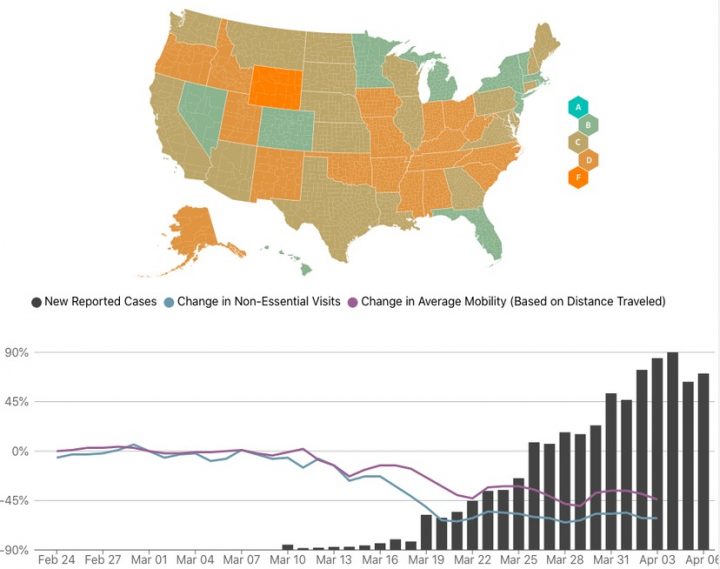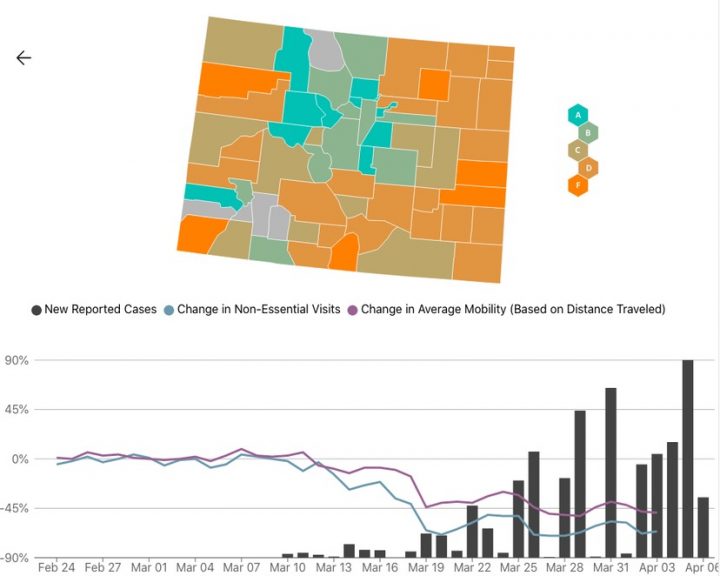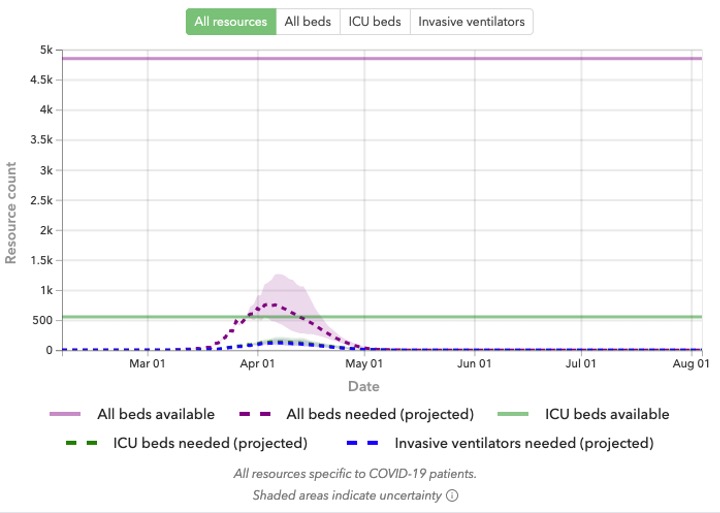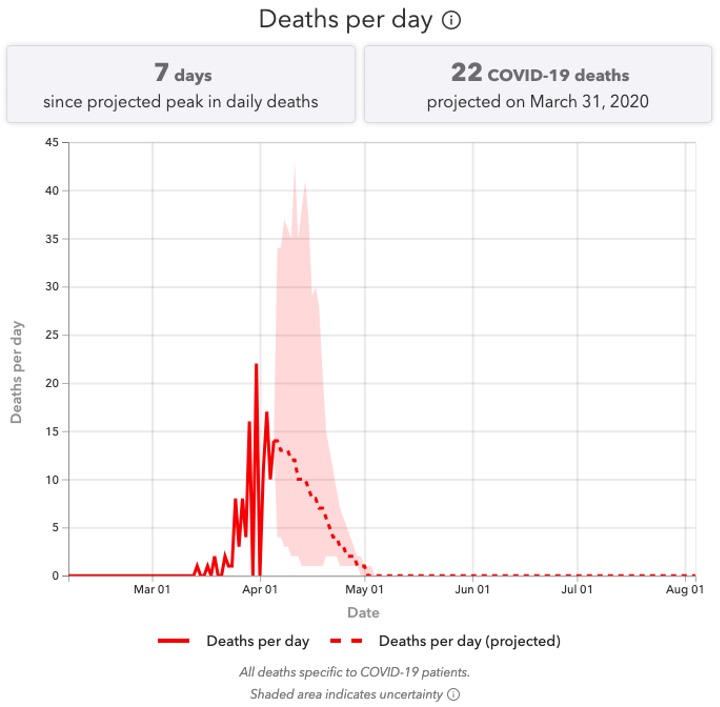The usual aphorism goes like this: “All models are wrong, but some are useful.”
But the Royal Statistical Society used the following title for their March 31 article:
All models are wrong, but some are completely wrong.
So just how bad is this health emergency, through the eyes of a computer model? Depends on which model you want to believe.

As we mentioned in Part One, the Trump administration’s COVID task force recently announced that the US will likely see as many as 240,000 fatalities from the novel coronavirus. From the April 2 Washington Post:
Leading disease forecasters, whose research the White House used to conclude 100,000 to 240,000 people will die nationwide from the coronavirus, were mystified when they saw the administration’s projection this week.
The experts said they don’t challenge the numbers’ validity, but that they don’t know how the White House arrived at them.
The University of Washington’s Institute for Health Metrics and Evaluation (IHME) issued a prediction on Monday that 81,766 Americans will die of COVID-19 through early August. For purposes of comparison, that’s just slightly more than the total populations of La Plata and Archuleta counties combined. These two counties currently have 35 ‘confirmed cases’ between them, and no reported fatalities.
If the IHME’s updated model were correct, and if La Plata and Archuleta suffered the same percentage of fatal cases as the rest of America, we would ultimately see two COVID fatalities between the two counties.
Predictions like those from the University of Washington are based on computer models, which are in turn based on what computer programmers believe about the world, and their ability to convert their beliefs into numerical inputs. Although some folks working in Artificial Intelligence might argue the point, computers view the world as strings of numbers. So any prediction a computer model spits out is almost certain to be numerical. You need numerical inputs; you get a numerical output.
“If 50% of the people in Colorado maintain at least a six-foot distance from every other person in Colorado, five days a week, while washing their hands for 15 seconds every 3 hours, and they live within 15 miles of a hospital with 40 percent of the ICU beds filled, and the turn-around on COVID testing is 4 days, then the number of fatalities between April 1 and April 30 will be X.”
“But if 30% of the people in Colorado maintain only a three-foot distance…”
All models are wrong, but some appeal to certain political agendas.
A Daily Post reader sent me a link, yesterday, to an April 7 Wall Street Journal op-ed by columnist James Freeman, titled, “The Big Virus Short”. A hedge fund manager named Michael Burry collected $100 million by ‘shorting’ the bond market — betting that mortgage-backed securities would fall in value — during the financial meltdown in 2008. He was portrayed by actor Christian Bale in the 2015 “true story” movie, The Big Short.
Mr. Burry, who also has a medical degree, was quoted in Mr. Freeman’s op-ed:
“Universal stay-at-home is the most devastating economic force in modern history,” Burry wrote in an email to Bloomberg News. “And it is man-made. It very suddenly reverses the gains of underprivileged groups, kills and creates drug addicts, beats and terrorizes women and children in violent now-jobless households, and more. It bleeds deep anguish and suicide.”
Dr. Burry told Bloomberg that he would “lift stay-at-home orders except for known risk groups. We already know certain conditions that are predictive of severe disease. Especially since young healthy lungs tend to be resistant, I would let the virus circulate in the population that is not likely to get severe disease from it. This is the only path that comes close to balancing the needs of all groups.”
Dr. Burry has an apparent knack for analyzing certain unusual situations, and I’m sure some of our Daily Post readers would agree with Dr. Burry’s recommendations. But the comments quoted by the Wall Street Journal do not reveal which computer model, if any, the good doctor is using to support his assertions. He might be offering a simple ‘seat-of-the-pants’ recommendation.
Colorado Governor Jared Polis and other state officials have been relying on a model built by researchers at the University of Colorado Anschutz Medical Campus. The model assumes that there are currently 17,000 to 18,000 cases of COVID-19 in Colorado — and that the state will be able to avoid overwhelming its hospital system only if Coloradans do a really good job of staying home.
A different computer program, meanwhile, has been analyzing human behavior across the US, based on the theory that social distancing can flatten the infection curve. The results are being displayed on the Unacast.com website. The computer has colored-coded areas of the country to illustrate which areas are doing the best — or worst — at practicing social distancing. As of April 7, the nation as a whole was given a “C” grade by Unacast.
Colorado was given a “B-” score…

Colorado appears to be surrounded by states that earned grades “C” “D” or “F”. (Time to close the borders?)
Unacast also ranks Colorado’s individual counties by their willingness to practice social distancing. Archuleta County is doing pretty well, earning a “B-“. The “A” grades (turquoise blue) seem to apply to wealthier urban cities and upscale mountain resort communities.

All of which suggests that any computer model aimed at calculating numbers for the entire nation will be seriously off-base if we are thinking about a small mountain community in southern Colorado. You might even expect it to be “completely wrong.”
But before we leave the world of computerized statistics, let’s talk briefly about Pickleball.
Archuleta County has an active community of Pickleball players, almost all of whom are over 60 years old — the demographic most at risk from the novel coronavirus. Their preferred venue, the Ross Aragon Community Center, has been closed to the public these past couple of weeks, but at some point — we are sure — play will be able to resume. But under what circumstances? Will players be required to wear masks? Will the ball be treated with hand sanitizer before each serve?
A lively email exchange of ideas between the club members included a link to the HealthData.org website, which appears to be operated by IHME. And here are a couple of graphs for Colorado:

The chart above suggests that — according to the IHME model — Colorado has already reached its peak use of hospital beds statewide, and from here on out, the number of beds needed will be declining. Of course, there might still be bed shortages in certain communities, but statewide, we are already at the peak?
The next chart is a projection of fatalities. The IHME model thinks that we hit the peak on March 31, and that over the long haul, we will see about twice our current number of COVID deaths: 179. So perhaps 360 fatalities, in total, with the last COVID deaths taking place around May 1.

The dotted line is the computer’s best guess about the future. The pink ‘shaded’ area shows an allowance for the dotted line projection to be very wrong.
